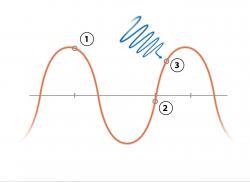Plucking the two electrons out of helium atoms should allow researchers to study how they interact during a double ionization process — at least in theory. Recently, Fellow Andreas Becker explored whether an ultrashort vacuum ultraviolet (VUV) laser pulse could be used to probe the interactions of helium’s electrons during a double ionization in the presence of an intense infrared (IR) laser field. Becker collaborated with research associate Shaohao Chen and a colleague from the Centro de Laseres Pulsados Ultraintensos Ultracortos (Salamanca, Spain) on the project.
Becker hoped that by monitoring the intricate dance of electrons during ionization, he could open the door to a better understanding of electron dynamics not only in atoms, but also in molecules, and larger structures. However, as often happens in fundamental research, monitoring the behavior of electrons during ionization of a helium atom turned out to be more challenging than expected. Rather than probing the dance of electrons, the VUV laser pulse induced new dynamics into the ionization process that couldn’t be separated from what was occurring in response to the IR laser field.
For instance, the researchers had hoped to better understand the behavior of excited states of a helium atom (He+) that had lost one of its electrons, but they were unable to find a trace of the excited states of He+ among all the other signals in their models of the interaction of the IR and VUV pulses. They also hoped to be able to use the VUV pulse to control the effects of the IR laser on helium ionization. Instead, they found that they could use the IR pulse to control the fate of an electron set free by the VUV pulse!
The researchers also learned that after an IR laser had knocked one electron out of the atom (exciting the second electron), a VUV pulse could easily knock the second electron out of the atom. Since the IR laser by itself can cause a double ionization, this finding underscored the complexity of the system Becker and his colleagues were trying to study.
Part of the difficulty was that the researchers are as yet unable to perform the full six-dimensional calculation required to fully model the double ionization of a helium atom. Becker and his colleagues are currently working to improve their three-dimensional model by expanding it into four and then five dimensions. They also plan to continue to investigate correlations between the two electrons during laser illumination. - Julie Phillips




